“My home is the result of a series of miracles.” This is the way Elizabeth Murray, an award-winning author, artist, photo-grapher, lecturer and expert on Monet’s gardens in Giverney, describes her circa-1900 home. Built originally by the renowned nocturnal artist Charles Rollo Peters, her home is actually a pair of classic single-wall cottages anchored by a main house, all of which are surrounded by natural fencing and tucked within a close of fruit, pine, cypress, oak and birch trees. In 1906, Peters invited artists, left homeless by the San Francisco earthquake, to call Peters Gate home, thereby allowing them to continue with their work. He negotiated gallery space with the Del Monte Hotel, a nearby luxury resort that attracted wealthy tourists from around the world, and provided his guests with an outlet for their work while San Francisco was rebuilt. He left for France in 1909 and never returned to his sixty-acre Monterey estate.
Over the course of the next seventy-five years, the property took on several owners, none of whom afforded it the attention it deserved. Enter Elizabeth Murray. Spiritual in demeanor but with the determination, conviction and strength of a triathlete, she pursued Peters Gate in 2000. With the cottage not yet under the protection of the National Historic Trust, Elizabeth competed with deep-pocket developers who spoke of significant change or destruction. With just days to act and outgunned financially by those competitors, she convinced the owners that Peters Gate deserved to remain intact, that it should receive the historic protection it deserved, that it would be restored to its turn-of-the-century glory, that grant funding would follow and that she was the person who would make it happen. She convinced the City of Monterey to direct some historic planning funds her way. And she received funding from some local angels and convinced the sellers to carry back the bulk of the home loan while she put her game plan into action. She kept her word, and within a year, Peters Gate was listed in the National Historic Register. She arranged for significant structural improvement including ceiling repair, three new fireplaces and new plumbing—all with the help of Monterey architect Terry Wilson. The two adjacent structures were turned into rental units. Elizabeth has renewed Peters’s original commitment to newly emerging artists and artistic sponsors by opening the structure to classes, lectures and creativity workshops—all this while working on a children’s book and a follow-up book about Monet’s gardens.
The multileveled landscape, lacking in character when the home was purchased, has been graced with over twenty-seven varieties of plants, trees and shrubs—most of them indigenous to the area. Nothing is wasted. When asked about a pile of old brick stacked neatly in the middle of a walkway, she responded, “That brick will be put to good use. I’ve spent the past six years pulling rocks and brick from one end of the property and moving them to another. I always find good use for the material.” And so she has, maintaining certain Bohemian touches throughout the property as Peters himself might have done—including outdoor fixtures that allow her to shower under the stars. The main house, though large, has all the qualities of a vintage cottage. The red-painted wooden structure sits unobtrusively under large shade trees with all of its rooms serving a purpose.
The interior glows with the hue of the amber redwood. Murray’s studio can be found on one level with the end result—her plein air paintings—displayed throughout the house. The great room is the primary living and gathering space with friends, featuring high ceilings, floor-to-ceiling wood-paneled windows, a hearty fireplace and a magnificent chandelier. The fixture was not in existence during Peters’s occupancy but would likely have been approved by the artist after listening to Elizabeth’s reasons for its inclusion.
She claims that the ghost of Peters walks throughout the property—she has sensed him and so has her dog, Toulie, short for Toulouse Lautrec, an adorable ten-year-old Couton du Tular. The blending of gentle spirits across more than a century makes Peters Gate a very special place.
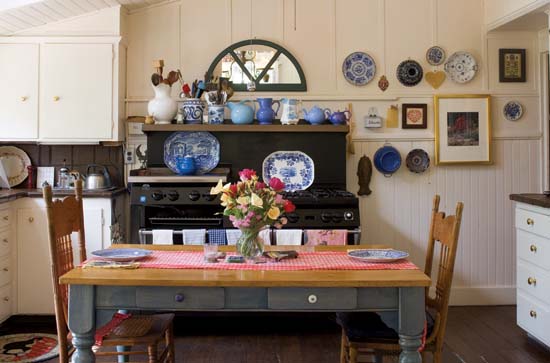
The original circa-1900 stove in perfect working condition highlights the spacious American farm kitchen and is a favorite meeting place for family and guests alike.
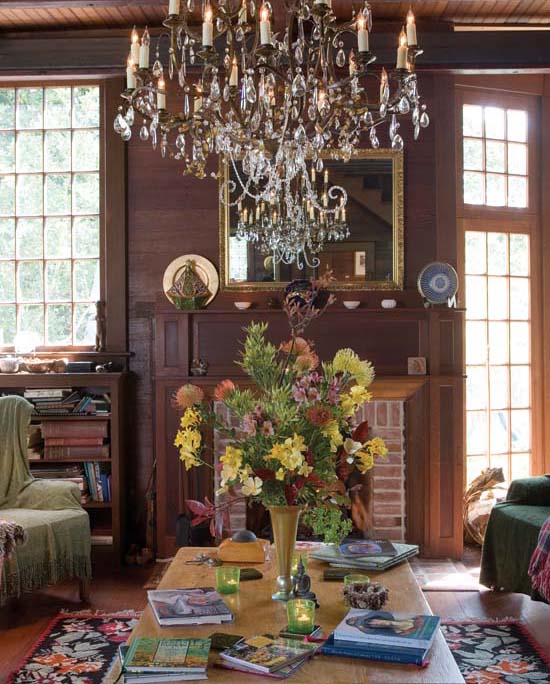
An antique chandelier is the centerpiece to the vaulted-ceiling living room. Light pours in from all directions thanks to floor-to-ceiling windows.
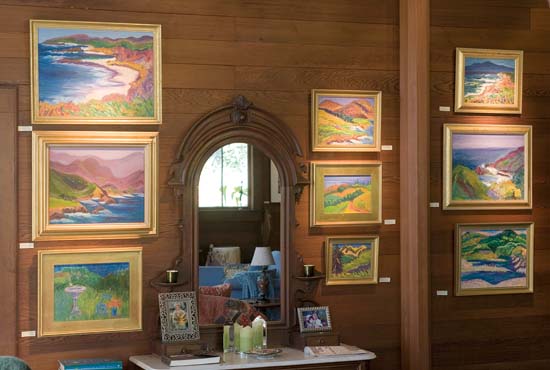
Elizabeth’s work hangs throughout the house, consistent with the origins of Peters Gate.
The interior glows with the hue of the amber redwood. Murray’s studio can be found on one level with the end result—her plein air paintings—displayed throughout the house.
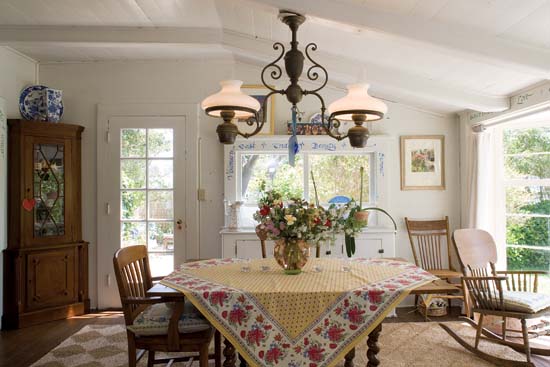
A spacious dining room runs adjacent the living room and is only steps from the great country kitchen.
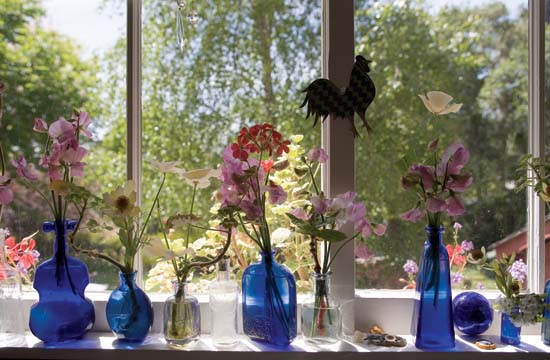
A row of antique hand-blown blue glass from the mid- to late nineteenth century provide prism-like colors based upon the sun’s angle.
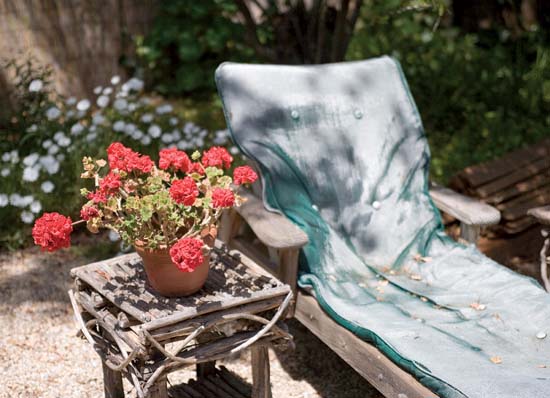
In late afternoon, this vintage wooden chaise beckons even the busiest artist or writer and is located in a grove of century-old trees.
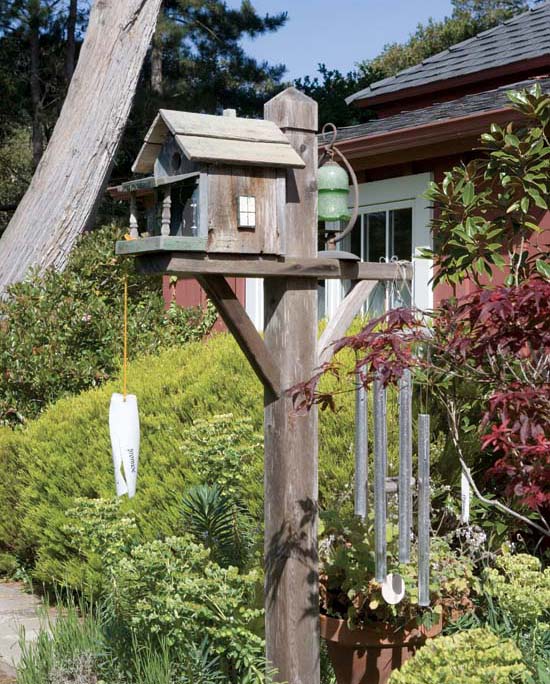
The rough-hewn handcrafted mailbox was made by a local craftsman.
There are Bohemian touches throughout the property as Peters himself might have done. The main house, though large, has all the qualities of a vintage cottage.
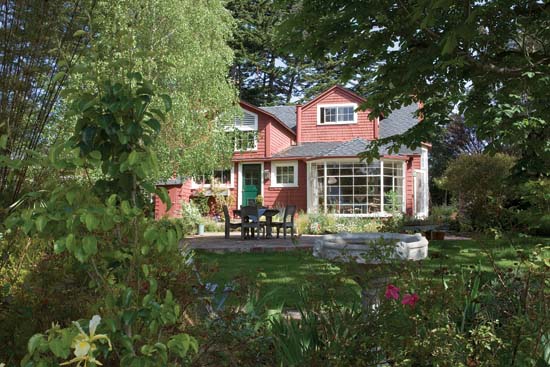
Peters Gate, restored with loving care, continues to be a teaching and interactive venue for artists and seekers, just as it did in 1900.